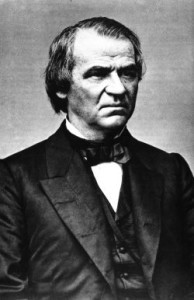The Initial Interpretation of Reconstruction
Led by historian William Dunning (Reconstruction, Political and Economic, 1907), this interpretation can be summarized as: “When the Civil War ended, the white South genuinely accepted the reality of military defeat, stood ready to do justice to the emancipated slaves, and desired above all a quick reintegration into the fabric of national life. Before his death, Abraham Lincoln had embarked on a course of sectional reconciliation, and during Presidential Reconstruction (1865-1867) his successor, Andrew Johnson (in photograph), attempted to carry out Lincoln’s magnanimous policies. Johnson’s efforts were opposed and eventually thwarted by the Radical Republicans in Congress. Motivated by an irrational hatred of Southern ‘Rebels’ and the desire to consolidate their party’s national ascendancy, the Radicals in 1867 swept aside the Southern governments Johnson had established and fastened black suffrage upon the defeated South. There followed the sordid period of Congressional or Radical Reconstruction (1865-1877), an era of corruption presided over by unscrupulous ‘carpetbaggers’ from the North, unprincipled Southern white ‘scallywags’ and ignorant freedmen. After much needless suffering, the South’s white community banded together to overthrow these governments and restore ‘home rule’ (a euphemism for white supremacy). All told, Reconstruction was the darkest page in the saga of American history.”
[Per Foner] Refutation of the Dunning School – largely based on a doctrine of “Negro incapacity” – took the better part of the following (twentieth) century.
— New, more favorable biographies of Andrew Johnson in the 1920s and 1930s altered views on his role, another basis of the Dunning School’s view.
— In 1935, although largely ignored at the time, black historian and activist W.E.B. DuBois (Black Emancipation in America), “portrayed Reconstruction as an idealist effort to construct a democratic, interracial political order from the ashes of slavery, as well as a phase in a prolonged struggle between capital and labor for control of the South’s economic resources.” [Foner] DuBois indicted historians for failure to see the emancipated slave as the principal actor in Reconstruction (a continuation of previous anti-black interpretations). Historian Howard K. Beale in 1940 called for a revisionist movement which rejected favorable views of white supremacists “saving” the South from “Negro Rule” during Reconstruction.
— During the 1940s, ’50s and ’60s historians increasingly reexamined the primary source materials of Reconstruction and more objectively developed more sympathetic views toward freedmen.
— Scholarship, aligning with the 1960s civil rights era, finally dealt a death blow to the Dunning School’s interpretation of Reconstruction.
Foner’s analysis continues: After the 1960s Andrew Johnson was again viewed more negatively – “a stubborn, racist politician incapable of responding to the unprecedented situation which confronted him as President.” The Radical Republicans were reprieved as “idealist reformers genuinely committed to black rights” and no longer were seen as “stalking horses of Northern capitalism” and irrational vindictiveness.
“Negro Rule” was found to be largely a myth. Reconstruction was vindicated for its establishment of public schools, granting equal citizenship to blacks, and promotion of a revitalized Southern economy. Radical Republicans and Southern freedmen were the heroes. Southern white Democrats (or Redeemers) were the new villains. Because of Southern resistance to 1960s civil rights efforts, the positive gains of the 1870s were suddenly deemed “superficial.” Persistent racism was then seen as the true problem and the reason that negated efforts to extend justice to blacks and failures to create an economically viable black presence in the South through land distribution.
In the 1970s and 1980s black and white scholars concurred in these views, but then blamed the “conservatism” of Radical Republicans for lacks of progress. Now the army and the Freedmen’s Bureau were seen as working with former slaveholders to thwart freedmen’s rights and economic progress. The revolutionary or non-revolutionary nature of Reconstruction was argued.
What can be learned from this historiography – a history of history – to assist in understanding Reconstruction in Virginia and Stafford?
— The centrality of the black experience in Reconstruction (seeking political rights from the Federal government and state politics, as well as seeking economic viability through land distribution and wage-earning).
— The critical importance of a new Southern class structure and new systems of organizing labor: the readjustment of the planter and professional classes to new social and economic realities; and the rise of poor whites in the economic hierarchy. Increased opportunity for the lower strata of society.
— Slow evolution of racial attitudes and patterns of racial relations; and the complex interconnection of race and class in the postwar South.
— The surprising effect of Northern economic developments on Virginia and Stafford.

